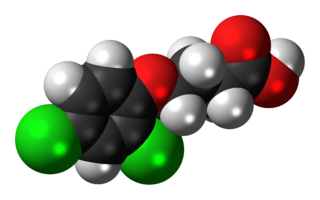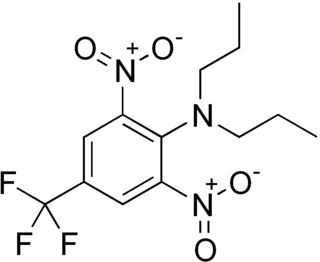
The halogens are a group in the periodic table consisting of six chemically related elements: fluorine (F), chlorine (Cl), bromine (Br), iodine (I), and the radioactive elements astatine (At) and tennessine (Ts), though some authors would exclude tennessine as its chemistry is unknown and is theoretically expected to be more like that of gallium. In the modern IUPAC nomenclature, this group is known as group 17.
A xenobiotic is a chemical substance found within an organism that is not naturally produced or expected to be present within the organism. It can also cover substances that are present in much higher concentrations than are usual. Natural compounds can also become xenobiotics if they are taken up by another organism, such as the uptake of natural human hormones by fish found downstream of sewage treatment plant outfalls, or the chemical defenses produced by some organisms as protection against predators. The term xenobiotic is also used to refer to organs transplanted from one species to another.

Pentachlorophenol (PCP) is an organochlorine compound used as a pesticide and a disinfectant. First produced in the 1930s, it is marketed under many trade names. It can be found as pure PCP, or as the sodium salt of PCP, the latter of which dissolves easily in water. It can be biodegraded by some bacteria, including Sphingobium chlorophenolicum.

Toxaphene was an insecticide used primarily for cotton in the southern United States during the late 1960s and the 1970s. Toxaphene is a mixture of over 670 different chemicals and is produced by reacting chlorine gas with camphene. It can be most commonly found as a yellow to amber waxy solid.

Hexazinone is an organic compound that is used as a broad spectrum herbicide. It is a colorless solid. It exhibits some solubility in water but is highly soluble in most organic solvents except alkanes. A member of the triazine class herbicides, it is manufactured by DuPont and sold under the trade name Velpar.
Microbial biodegradation is the use of bioremediation and biotransformation methods to harness the naturally occurring ability of microbial xenobiotic metabolism to degrade, transform or accumulate environmental pollutants, including hydrocarbons, polychlorinated biphenyls (PCBs), polyaromatic hydrocarbons (PAHs), heterocyclic compounds, pharmaceutical substances, radionuclides and metals.

The environmental effects of pesticides describe the broad series of consequences of using pesticides. The unintended consequences of pesticides is one of the main drivers of the negative impact of modern industrial agriculture on the environment. Pesticides, because they are toxic chemicals meant to kill pest species, can affect non-target species, such as plants, animals and humans. Over 98% of sprayed insecticides and 95% of herbicides reach a destination other than their target species, because they are sprayed or spread across entire agricultural fields. Other agrochemicals, such as fertilizers, can also have negative effects on the environment.

2,4-DB or 4-(2,4-dichlorophenoxy)butyric acid is a selective systemic phenoxy herbicide used to control many annual and perennial broad-leaf weeds in alfalfa, peanuts, soybeans, and other crops. Its active metabolite, 2,4-D, inhibits growth at the tips of stems and roots. It is classified in toxicity class III. It shows some evidence of toxicity to dogs and cats, such as changes in body weight and reduced numbers of offspring, when fed 25-80 milligrams per kilogram of body weight for prolonged periods. Tests of carcinogenicity in this range yielded differing results. It is moderately toxic to fish.

Trifluralin is a commonly used pre-emergence herbicide. With about 14 million pounds (6,400 t) used in the United States in 2001, it is one of the most widely used herbicides. Trifluralin is generally applied to the soil to provide control of a variety of annual grass and broadleaf weed species. It inhibits root development by interrupting mitosis, and thus can control weeds as they germinate.
Organobromine chemistry is the study of the synthesis and properties of organobromine compounds, also called organobromides, which are organic compounds that contain carbon bonded to bromine. The most pervasive is the naturally produced bromomethane.
Organoiodine chemistry is the study of the synthesis and properties of organoiodine compounds, or organoiodides, organic compounds that contain one or more carbon–iodine bonds. They occur widely in organic chemistry, but are relatively rare in nature. The thyroxine hormones are organoiodine compounds that are required for health and the reason for government-mandated iodization of salt.
This is an index of articles relating to pesticides.

Monolinuron is a pesticide, more specifically a selective systemic herbicide and an algaecide. As an herbicide, it is used to control broad-leaved weeds and annual grasses in vegetable crops such as leeks, potatoes, and dwarf French beans. Monolinuron affects the photosynthesis in weeds. Following uptake of monolinuron through roots and leaves of weeds, monolinuron causes early symptoms of yellowing and die-back of the leaves, eventually resulting in weed death. In fishkeeping, it is used to control blanket weed and hair algae.

Acetamiprid is an organic compound with the chemical formula C10H11ClN4. It is an odorless neonicotinoid insecticide produced under the trade names Assail, and Chipco by Aventis CropSciences. It is systemic and intended to control sucking insects (Thysanoptera, Hemiptera, mainly aphids) on crops such as leafy vegetables, citrus fruits, pome fruits, grapes, cotton, cole crops, and ornamental plants. It is also a key pesticide in commercial cherry farming due to its effectiveness against the larvae of the cherry fruit fly.

Aminomethylphosphonic acid (AMPA) is a weak organic acid with a phosphonic acid group.

Bentazon is a chemical manufactured by BASF Chemicals for use in herbicides. It is categorized under the thiadiazine group of chemicals. Sodium bentazon is available commercially and appears slightly brown in colour.
Pesticide degradation is the process by which a pesticide is transformed into a benign substance that is environmentally compatible with the site to which it was applied. Globally, an estimated 1 to 2.5 million tons of active pesticide ingredients are used each year, mainly in agriculture. Forty percent are herbicides, followed by insecticides and fungicides. Since their initial development in the 1940s, multiple chemical pesticides with different uses and modes of action have been employed. Pesticides are applied over large areas in agriculture and urban settings. Pesticide use, therefore, represents an important source of diffuse chemical environmental inputs.
Adsorbable organic halides (AOX) is a measure of the organic halogen load at a sampling site such as soil from a land fill, water, or sewage waste. The procedure measures chlorine, bromine, and iodine as equivalent halogens, but does not measure fluorine levels in the sample.

Cyanazine is a herbicide that belongs to the group of triazines. Cyanazine inhibits photosynthesis and is therefore used as a herbicide.

Butamifos is an herbicide that is used to control weeds.














